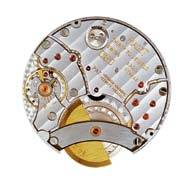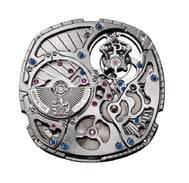
Cutting Edge: Piaget And The Mastery Of Ultra-Thin Watchmaking
Even among experts, the name Piaget often evokes conflicting images. When one thinks of Piaget, the first things to come to mind are exotic high jewelry timepieces that adorn the wrists of some of the world’s most elegant and fashionable women. With a history of creating spectacular jeweled watches–and spectacular jewelry–it’s understandable that even among watch enthusiasts there are many who don’t realize that Piaget is also one of the technical powerhouses of the Swiss watch industry, and in an arena where only the most sophisticated fine watchmaking firms can compete– the making of ultra-thin watches.
Part of the confusion stems from the fact that though Piaget was founded well over a century ago–the company traces its roots to the village of La Côte-aux-Fées where the Piaget family established its first watchmaking workshop in 1874– and for much of their history, they made watch movements for other companies to sell under other names. Piaget supplied ultra-thin movements to some of the most prestigious fine watchmaking firms throughout the 1920s and ‘30s when very flat watches were de rigueur for any man of style–whether for the pocket or for the wrist–but they didn’t start selling watches under their own name until 1943.
To understand Piaget’s reputation and accomplishments, it’s important to understand why for centuries, the making of ultra-thin watches was considered an expression of one of the highest levels of skill in watchmaking. It’s a funny thing, but even today, there’s no universally agreed upon definition of an ultra-thin watch. The industry’s “bible,” the Berner Dictionary of Horology, merely says that an ultra-thin watch is one that is “very thin.” The problem is basically that watches don’t want to be thin; like any machine, they’d like to be built as solidly as possible, which is why things like the wonderful marine chronometers of yesteryear–ultra precise clocks that were used on ships for navigation–were massively thick devices of brass and steel. Even today most watchmakers give themselves an edge by avoiding making movements any thinner than necessary.
An ultra-thin (or extra slim, or extra flat–the terms are used pretty interchangeably) watch, on the other hand, has to be made to incredibly precise tolerances in order for it to run as well as its thicker counterparts. All the clearances are much smaller; gears have to be literally hair-thin–Piaget’s newest ultra thin automatic movement has some gears only 0.12mm thick–and for the whole watch to be elegantly flat, even the space between the hour and minute hands has to be reduced to a bare minimum. On top of all that, great care has to be taken to make sure that the watch case, though thin, is rigid enough to protect the movement; some ultra-thin watches are so thin that they’re in danger of stopping if the strap is tightened too much, which can actually make the movement bend.
Given all these challenges, Piaget’s many decades of consistent leadership in making ultra-thin watches is even more impressive. The company wasted little time in making sure it made its mark under its own name in the domain in which it had labored so long for the benefit of other brands. In 1957, Piaget produced one of the most amazing movements in the history of watchmaking: the now-famous calibre (the technical term for a watch movement) 9P, which was at the time the world’s thinnest manual-wind watch movement at only 2mm thin. This was followed only two years later by another incredible achievement: the Piaget calibre 12P, which was a self-winding, or automatic, movement. It was like the 9P, a world record at the time–so much so that it was entered into the Guinness Book of World Records for its incredibly slim profile (only 2.3mm thin.)
Piaget did not merely rest on its laurels, either. Through the subsequent years, it continued to create some of the world’s thinnest movements, often for watches in its historic Altiplano range. These included both simple and complicated movements, such as the world’s thinnest shaped tourbillon movement (the calibre 600P, only 3.5mm) and the amazing complicated movement calibre 855P, which incorporates a perpetual calendar with retrograde displays and a dual time zone indication in a movement a mere 5.6mm thick.
Perhaps Piaget’s greatest moment since it first began making watches under its own name in 1943, however, came in 2011. That was the year that Piaget introduced two new movements: the calibre 1200P, in a 43mm Anniversary Edition of the Altiplano watch, and the calibre 1208P (which can be distinguished from the 1200P by the addition of a small seconds subdial) in a non-limited production version of the 43mm Altiplano. Both the 1200P and 1208P movements are record-breakers. At only 2.35mm thick they are the thinnest self-winding movements in the world; and the entire Altiplano 43mm watch is, at only 5.25mm thick overall, thin enough to shave with.
As if that weren’t enough the firm also recently debuted a new ultra thin automatic tourbillon –the Piaget Emperador Coussin Tourbillon Automatic Ultra Thin, with a self winding movement –the calibre 1270P –that measures only 5.35mm thick.
Thin, goes the conventional wisdom, is in, in watchmaking nowadays. Thanks to the conveniently loose definition of the term “ultra-thin” in watchmaking, there are any numbers of pretenders to the throne. But you can’t make a watch a true ultra-thin watch just by calling it that. The exceptional engineering talent at Piaget isn’t a thing of the moment, or the result of reacting to a fad. It’s just the ongoing expression of a persistent dedication to the highest level of craft in one of the most challenging –but also most aesthetically rewarding –forms of watchmaking.
 SIGN UP
SIGN UP














